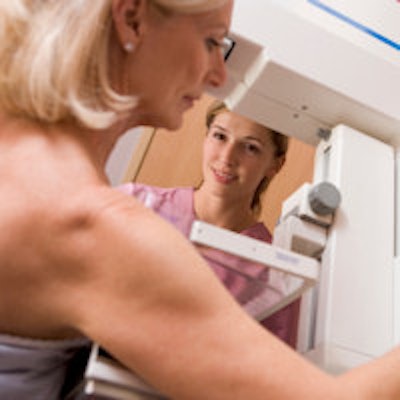
A new literature review published in the April issue of the Journal of the American Medical Association tries to clear the confusion of the breast screening debate by summarizing what is known about the benefits and risks of mammography. The authors hope the information will help women make more informed choices about breast screening.
Dr. Lydia Pace and Dr. Nancy Keating from Brigham and Women's Hospital performed a meta-analysis and concluded that mammography screening reduced mortality from breast cancer by 19%, though the figure varied greatly based on age (JAMA, April 2, 2014, Vol. 311:13, pp. 1327-1335).
On the risk side of the coin, they found that a 40- or 50-year-old woman who underwent annual mammography for 10 years would have a 61% risk of a false positive and a 19% overdiagnosis rate (defined as cancers that would never become apparent without screening).
The researchers hope the numbers will provide some solid footing in an otherwise fluid debate over breast screening.
 Dr. Nancy Keating from Brigham and Women's Hospital.
Dr. Nancy Keating from Brigham and Women's Hospital.
"There's been huge controversy following the [U.S. Preventive Services Task Force (USPSTF)] 2009 recommendations -- a lot of clinicians disagree with them," Keating told AuntMinnie.com. "But I think it's also true that we've been overselling mammography for years. It has benefits, but it's not perfect, and that's important for patients to understand."
Roots in 2009 USPSTF decision
The current debate over mammography screening was sparked by the 2009 USPSTF decision to revise its mammography screening guidelines. The task force advised women older than 50 to undergo screening every two years and reversed its previous recommendation that women start screening in their 40s every one or two years.
USPSTF also advised women and physicians to base their screening decisions on an analysis of the benefits and harms of mammography, but the researchers found little information to help guide these decisions.
The current article tries to put this information at women's fingertips by presenting not only what's known about the benefits of mammography in terms of its mortality reduction, but also what's known about its drawbacks. Pace and Keating performed a Medline literature search from 1960 to 2014, looking for randomized clinical trial data, meta-analyses, systematic reviews, and observational studies.
They used 20 meta-analyses to assess the mortality benefit of mammography, focusing in particular on five studies published after 2006. To describe mammography's harms -- false positives, unnecessary biopsies, and overdiagnosis -- the researchers conducted two searches: The first included systematic reviews and meta-analyses through December 2008 (the review period that informed the USPSTF decision), and the second included primary studies and reviews published since that time. From these searches, Pace and Keating used 14 studies published before 2008 and 72 published after that year.
A meta-analysis of eight large randomized clinical trials (RCTs) that investigated breast cancer mortality associated with screening found a 15% to 20% decrease in the relative risk of breast-cancer-specific mortality, Pace and Keating wrote. They attributed the variation in estimates to differences in trial quality and inclusion criteria.
"Some argue that the RCTs are unlikely to be applicable to women undergoing screening today, because they preceded treatment advances that have powerfully influenced breast cancer mortality and used older mammography techniques," they wrote. "However, the RCTs nevertheless provide the best data available."
Estimating harm
Data from the Breast Cancer Surveillance Consortium in 2011 and 2013 suggest that the 10-year cumulative risk of at least one false-positive result is 61.3% for women starting screening at ages 40 or 50 and 49.7% for women ages 66 to 74 receiving annual screening, the authors wrote. Their review also suggested that about 19% of breast cancers fall into the overdiagnosis category.
Pace and Keating used statistics from the Surveillance, Epidemiology, and End Results (SEER) database, as well as a review by Dr. Gilbert Welch and Honor Passow, PhD, published in JAMA Internal Medicine (March 2014, Vol. 174:3, pp. 448-454), which incorporated data from the Canadian National Breast Screening Study (CNBSS), the Malmö breast cancer screening trial, and the Swedish Two-County trial.
| Benefits, harms of annual breast screening for 10,000 women over 10 years | ||||||
| Age | No. diagnosed with invasive breast cancer or DCIS during 10 years of screening | No. of breast cancer deaths in next 15 years | No. of deaths averted with mammography screening over next 15 years | No. of overdiagnosed breast cancers or DCIS found during 10 years of screening | No. with at least 1 false positive during 10 years of screening | No. with at least 1 unnecessary biopsy during 10 years of screening |
| 40 | 190 | 27-32 | 1-16 | ?-104 | 6,130 | 700 |
| 50 | 302 | 56-64 | 3-32 | 30-137 | 6,130 | 940 |
| 60 | 438 | 87-97 | 5-49 | 64-194 | 4,970 | 980 |
The information translates into a 19% overall mortality reduction for all women from their 40s to their 60s, but this varies greatly by age: Women in their 40s saw a 15% mortality reduction, while women in their 60s had a 32% reduction -- an indication of mammography's improved performance in older women.
The data indicate that the benefits and harms of mammography screening should be taken into account, along with a woman's individual risk factors, in determining whether and when to begin screening, Keating said.
"Breast cancer is a rare disease for women in their 40s," she said. "But if a healthy 40-year-old woman had twice the average risk of breast cancer because of dense breasts, she would be expected to have twice the average benefit of screening -- but also a higher risk of false-positive findings. In addition, women vary in how much they worry about the harms of mammography, particularly false positives."
Individualized assessment is best
Helping women make informed decisions about when to start breast cancer screening and how often to have the exam requires reconciling information about screening's risks and benefits with the patient's values, Keating said.
"I do talk with women in my practice about the benefits and harms of screening, and I do use tools such as the Gail model to help a woman get a sense of her risk average for her age," she told AuntMinnie.com. "I encourage them to learn more about the pros and cons of mammography screening, consider how they feel, and then make a decision. For women who want a mammogram, I'm certainly not going to talk them out of it, but they should understand the limitations of the test."
The bottom line is there's no one-size-fits-all approach to mammography screening, according to Keating.
"We're way past the point where we can just 'check the box' so that every patient gets one every year," she said.




















